Dielectric Properties of Isotactic Polypropylene with Lignocellulose-Based Biomass Filler
Abstract
1. Introduction
2. Materials and Methods
2.1. Materials
2.2. Sample Preparation
2.3. Methods
3. Results
3.1. Morphological Characterization
3.2. Change in Effective Dielectric Permeability
3.3. Change in Dielectric Loss Tangent
3.4. Optimization of the Dielectric Properties
4. Conclusions
Author Contributions
Funding
Institutional Review Board Statement
Informed Consent Statement
Data Availability Statement
Acknowledgments
Conflicts of Interest
References
- Thakur, M.K.; Rana, A.K.; Thakur, V.K. Lignocellulosic Polymer Composites: A Brief Overview. In Lignocellulosic Polymer Composites; Thakur, V.K., Ed.; Wiley: Hoboken, NJ, USA, 2015; pp. 1–15. [Google Scholar]
- Jefferson Andrew, J.; Dhakal, H.N. Sustainable biobased composites for advanced applications: Recent trends and future opportunities—A critical review. Compos. Part C 2022, 7, 100220. [Google Scholar]
- Masłowski, M.; Miedzianowska, J.; Strzelec, K. The potential application of cereal straw as a bio-filler for elastomer composites. Polym. Bull. 2020, 77, 2021–2038. [Google Scholar] [CrossRef]
- Musa, A.A.; Onwualu, A.P. Potential of lignocellulosic fiber reinforced polymer composites for automobile parts production: Current knowledge, research needs, and future direction. Heliyon 2024, 10, e24683. [Google Scholar] [CrossRef]
- Abdollahiparsa, H.; Shahmirzaloo, A.; Teuffel, P.; Blok, R. A review of recent developments in structural applications of natural fiber-Reinforced composites (NFRCs). Compos. Adv. Mater. 2023, 32, 26349833221147540. [Google Scholar] [CrossRef]
- Narayan Jha, S.; Narsaiah, K.; Basediya, A.L.; Sharma, R.; Jaiswal, P.; Kumar, R.; Bhardwaj, R. Measurement techniques and application of electrical properties for nondestructive quality evaluation of foods—A review. J. Food. Sci. Technol. 2011, 48, 387–411. [Google Scholar]
- Nelson, S.O.; Trabelsi, S. Use of material dielectric properties in agricultural applications. J. Microw. Power Electromagn. Energy 2016, 50, 237–268. [Google Scholar] [CrossRef]
- Nelson, S.O.; Trabelsi, S. Dielectric Properties of Grain and Seed and Their Usefulness in Sensing Physical Properties. In Proceedings of the ASABE Annual International Meeting Paper, Kansas City, MI, USA, 21 July–24 July 2013; p. 131498088. [Google Scholar]
- Jones, S.B.; Sheng, W.; Or, D. Dielectric Measurement of Agricultural Grain Moisture—Theory and Applications. Sensors 2022, 22, 2083. [Google Scholar] [CrossRef]
- Nelson, S.O. Review of factors influencing the dielectric properties of cereal grains. Cereal. Chem. 1981, 58, 487–492. [Google Scholar]
- Sacilik, K.; Tarimci, C.; Colak, A. Dielectric Properties of Flaxseeds as Affected by Moisture Content and Bulk Density in the Radio Frequency Range. Biosyst. Eng. 2006, 93, 153–160. [Google Scholar] [CrossRef]
- Nelson, S.O. 250-Hz to 12-GHz Dielectric Properties of Grain and Seed. Trans. ASAE 1975, 18, 714–715. [Google Scholar]
- Nelson, S.O. Dielectric Properties of Grain and Seed in the 1 to 50-MC Range. Trans. ASAE 1965, 8, 38–48. [Google Scholar]
- Nelson, S.O. Dielectric Properties of Agricultural Products: Measurements and Applications. IEEE Electr. Insul. 1991, 26, 845–869. [Google Scholar] [CrossRef]
- Nelson, S.O.; Trabels, S. Models for the microwave dielectric properties of grain and seed. Trans. ASABE 2011, 54, 549–553. [Google Scholar]
- Inegbenebor, A.O.; Adeniji, F.A. Electrical Insulative Properties of Some Agro-Waste Materials. West Indian J. Eng. 2007, 30, 17–26. [Google Scholar]
- Rajamanikandan, T.; Banumathi, S.; Karthikeyan, B. Investigation of the dielectric properties and mechanical stability of lignocellulosic biomass based electrical insulation material for high voltage applications. Mater. Res. Express 2023, 10, 085501. [Google Scholar]
- Iliyasu, I.; Yahaya, H.; Stephen, M. Dielectric Application of Agro-waste Reinforced Polymer Composites: A Review. Phys. Access 2023, 3, 59–68. [Google Scholar] [CrossRef]
- Zainol, N.; Mustafa, N.; Aziz, N.; Azman, A.N.; Karim, M.S.A. Dielectric materials development using bio-waste: A review. J. Elect. Syst. Inf. Technol. 2023, 10, 47. [Google Scholar]
- Bozovic, I.; Radosavljevic, M.; Zilic, S.; Jovanovic, R.A. genetic base of utilisation of maize cob as a valuable naturally renewable raw material. Genetika 2004, 36, 245–256. [Google Scholar]
- Radosavljevic, M.; Bozovic, I.; Jovanovic, R.; Zilic, S. The maize cob in the environmental protection. In Ecological Truth; Markovic, Z.S., Ed.; University of Belgrade Technical Faculty: Bor, Serbia, 2004; pp. 253–257. [Google Scholar]
- Jayamol, G.; Bhagawan, S.; Thomas, S. Electrical Properties of Pineapple Fibre Reinforced Polyethylene Composites. J. Polym. Eng. 1997, 17, 383–404. [Google Scholar]
- Paul, A.; Thomas, S. Electrical properties of natural-fibre-reinforced low-density polyethylene composites: A comparison with carbon black and glass-fibre-filled low-density polyethylene composites. J. Appl. Polym. Sci. 1997, 63, 247–266. [Google Scholar]
- Markiewicz, E.; Paukszta, D.; Borysiak, S. Dielectric properties of lignocellulosic materials-polypropylene composites. Mater. Sci.-Pol. 2009, 27, 581–594. [Google Scholar]
- Jayamania, E.; Hamdanb, S.; Rahman, M.R.; Bakri, M.K.B. Comparative study of dielectric properties of hybrid natural fiber composites. Procedia Eng. 2014, 97, 536–544. [Google Scholar] [CrossRef]
- Cerovic, D.D.; Petronijevic, I.M.; Dojcilovic, J.R. Influence of temperature and fiber structure on the dielectric properties of polypropylene fibrous structures. Polym. Advan. Technol. 2014, 25, 338–342. [Google Scholar] [CrossRef]
- Petronijevic, I.M.; Cerovic, D.D.; Dudic, D.A.; Dojcilovic, J.R.; Dojcinovic, B.P.; Pergal, M.V. Dielectric spectroscopy of nanocomposites based on iPP and aPS treated in the water solutions of alkali metal salts. Polym. Advan. Technol. 2018, 29, 1826–1833. [Google Scholar] [CrossRef]
- Nelson, S.O.; Stetson, L.E. 1976. Frequency and moisture dependence of the dielectric properties of hard red winter wheat. J. Agric. Eng. Res. 1976, 21, 181–192. [Google Scholar] [CrossRef]
- Jacob, M.; Varughese, K.T.; Thomas, S. Dielectric characteristics of sisal–oil palm hybrid fibre reinforced natural rubber biocomposites. J. Mater. Sci. 2006, 41, 5538–5547. [Google Scholar] [CrossRef]
- Cerovic, D.D.; Asanovic, K.A.; Maletic, S.B.; Dojcilovic, J.R. Comparative study of the electrical and structural properties of woven fabrics. Compos. B Eng. 2013, 49, 65–70. [Google Scholar] [CrossRef]
- Tsyganov, A.; Vikulova, M.; Artyukhov, D.; Bainyashev, A.; Goffman, V.; Gorokhovsky, A.; Boychenko, E.; Burmistrov, I.; Gorshkov, N. Permittivity and Dielectric Loss Balance of PVDF/K1.6Fe1.6Ti6.4O16/MWCNT Three-Phase Composites. Polymers 2022, 14, 4609. [Google Scholar] [CrossRef]
- Tsyganov, A.; Vikulova, M.; Zotov, I.; Artyukhov, D.; Burmistrov, I.; Gorokhovsky, A.; Gorshkov, N. Significantly Enhanced Balance of Dielectric Properties of Polyvinylidene Difluoride Three-Phase Composites by Silver Deposited on K2Ni0.93Ti7.07O16 Hollandite Nanoparticles. Polymers 2024, 16, 223. [Google Scholar] [CrossRef]
- Huang, Z.X.; Zhao, M.L.; Zhang, G.Z.; Song, J.; Qu, J.P. Controlled localizing multi-wall carbon nanotubes in polyvinylidene fluoride/acrylonitrile butadiene styrene blends to achieve balanced dielectric constant and dielectric loss. Compos. Sci. Technol. 2021, 212, 108874. [Google Scholar] [CrossRef]
- International Technology Roadmap of Semiconductors. 2013. Available online: http://www.itrs.net (accessed on 6 October 2024).
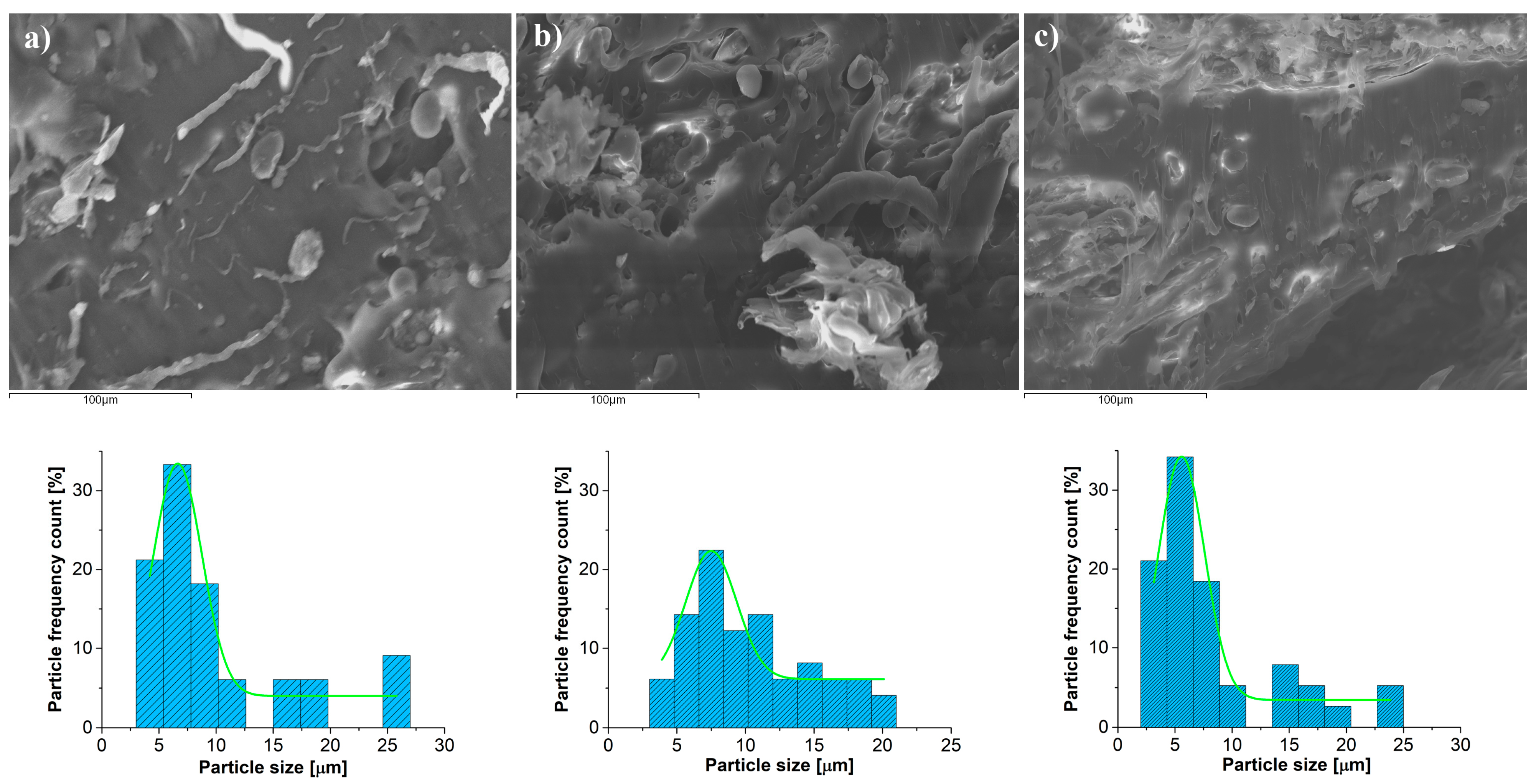

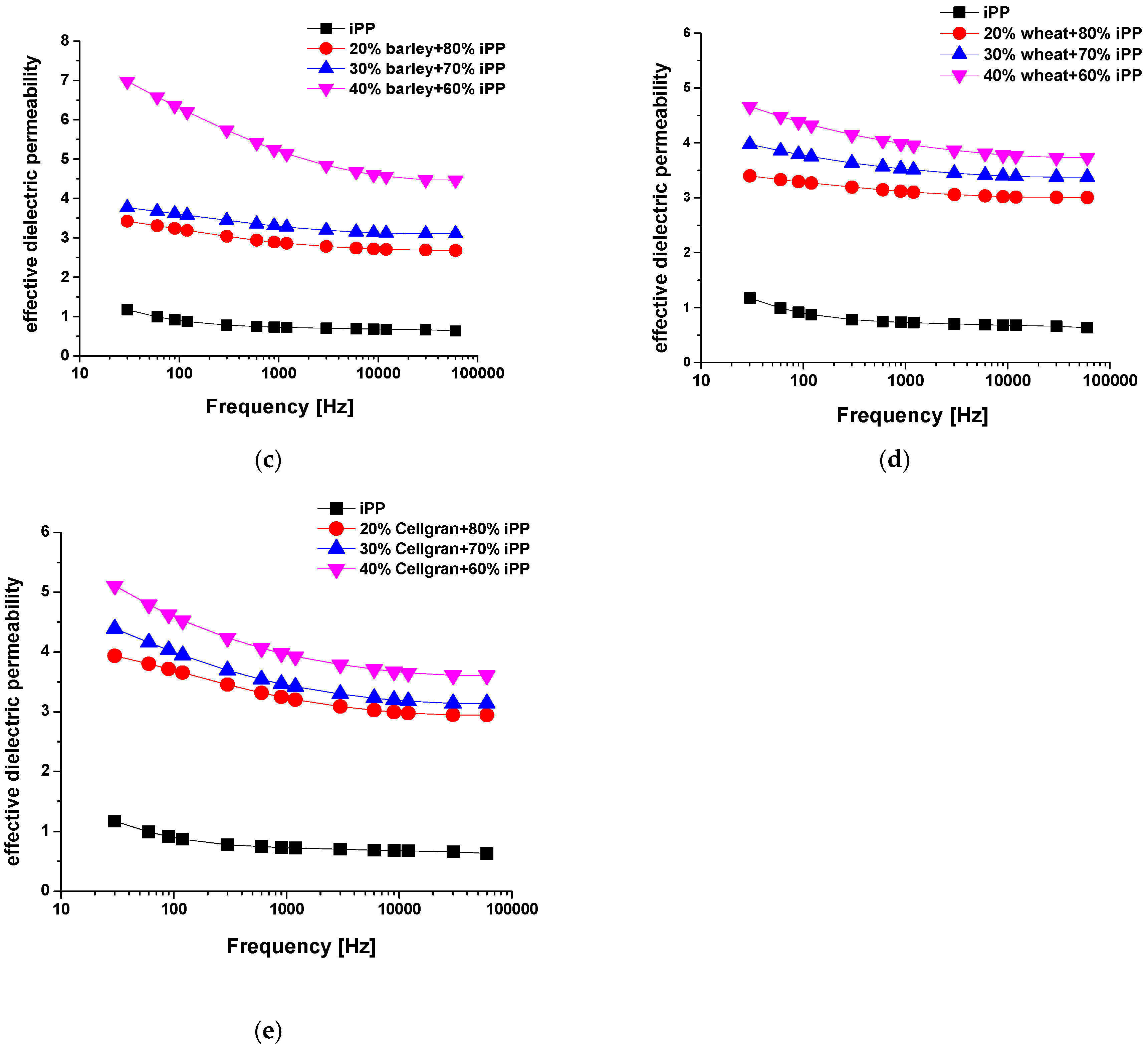

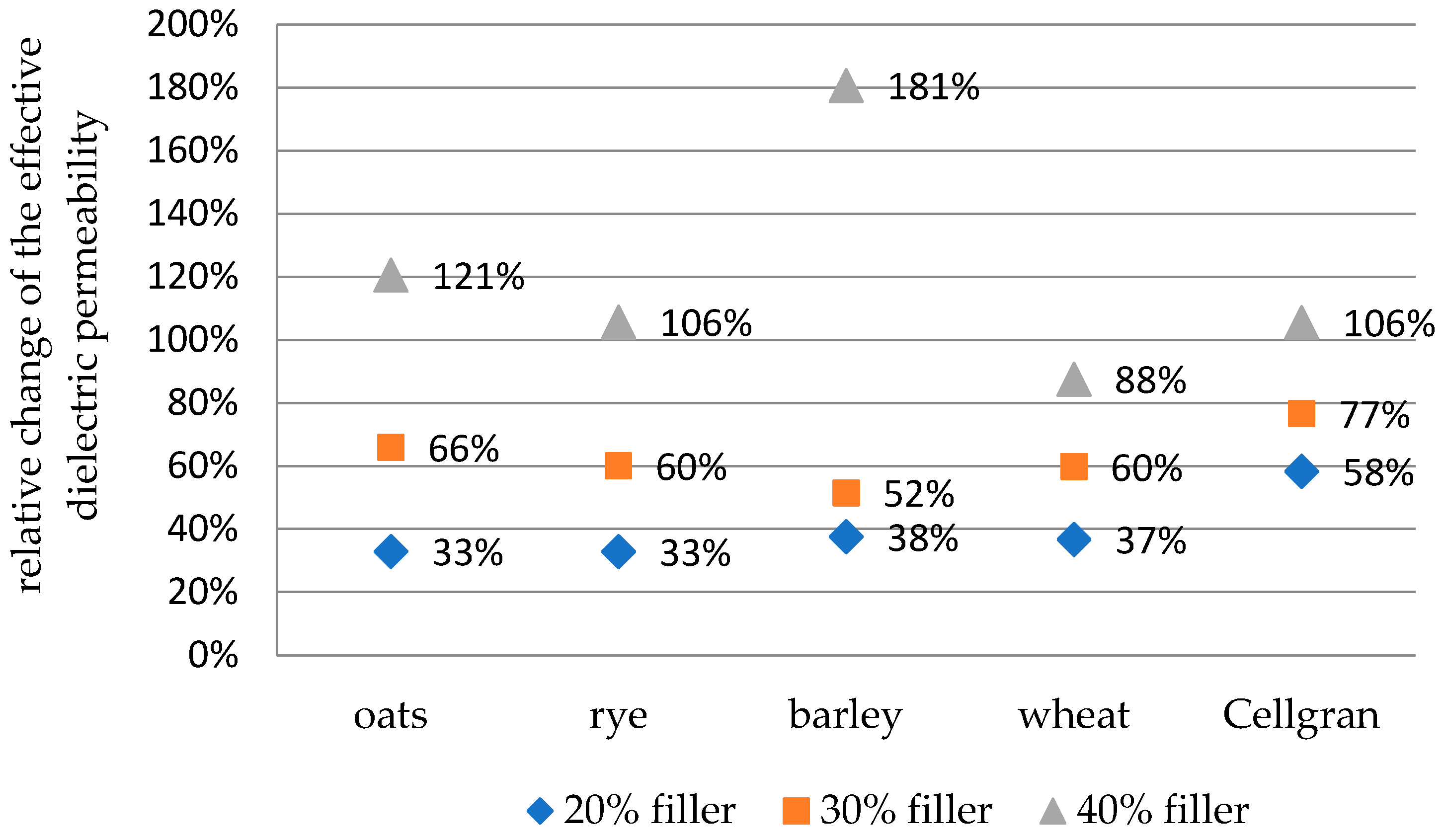
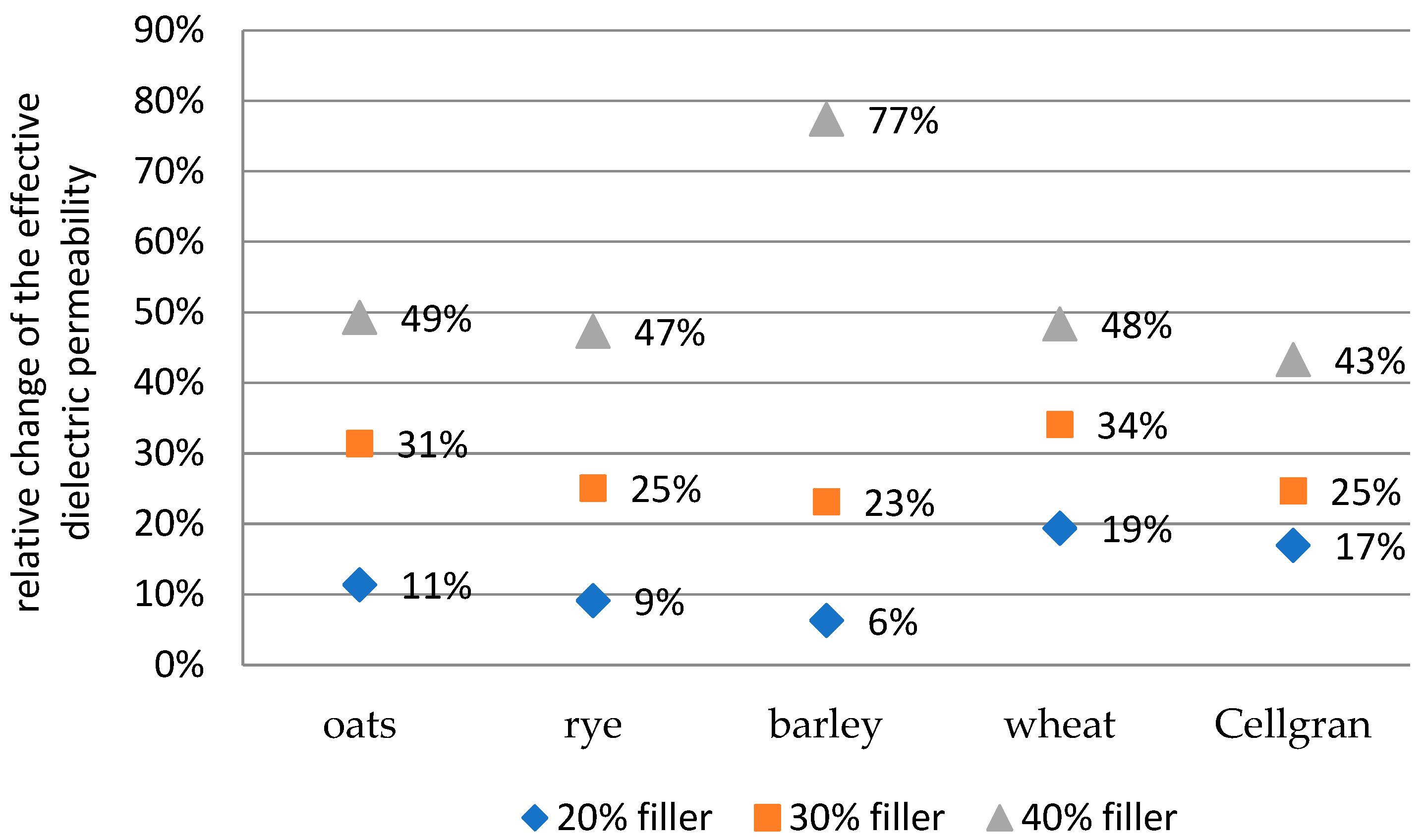
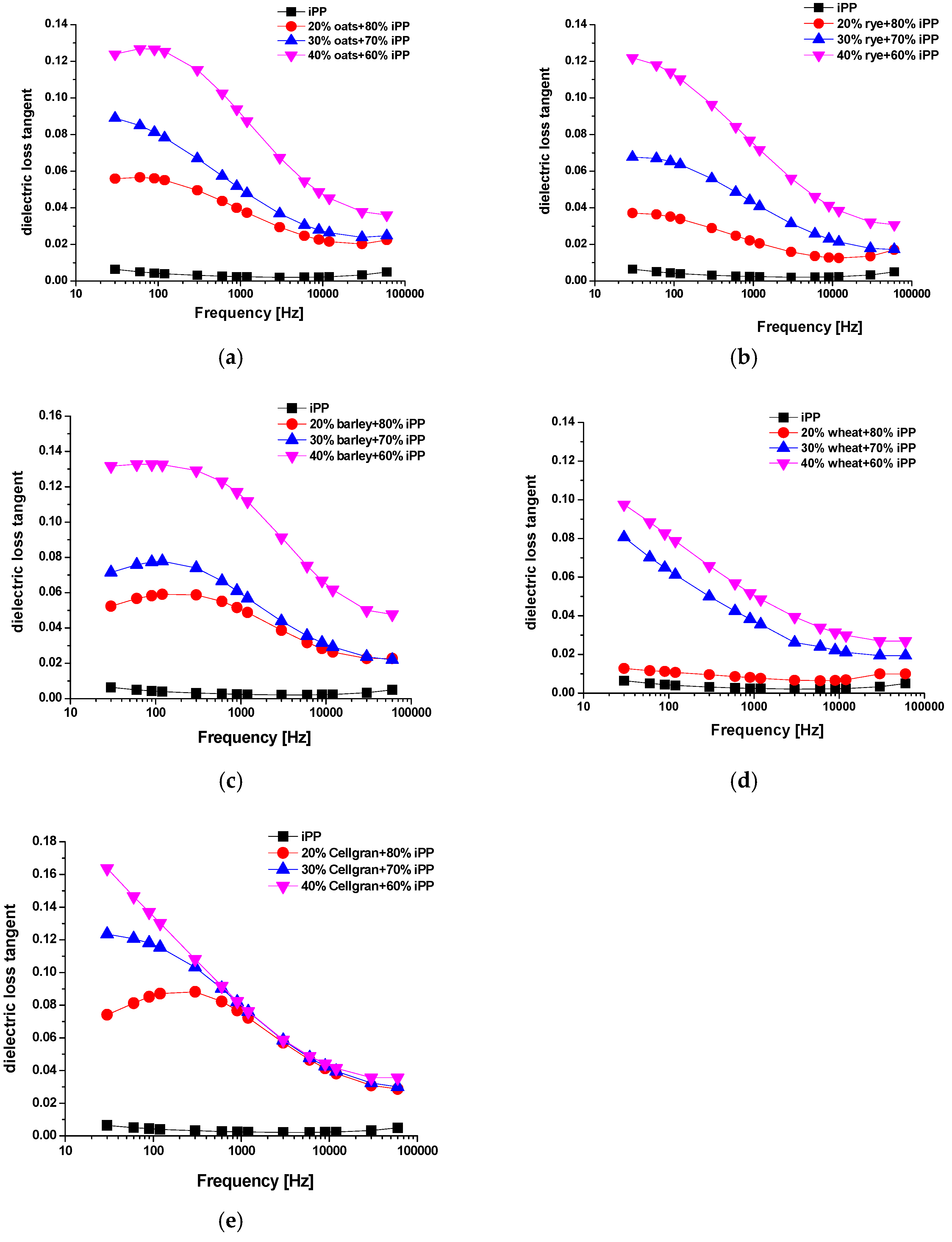
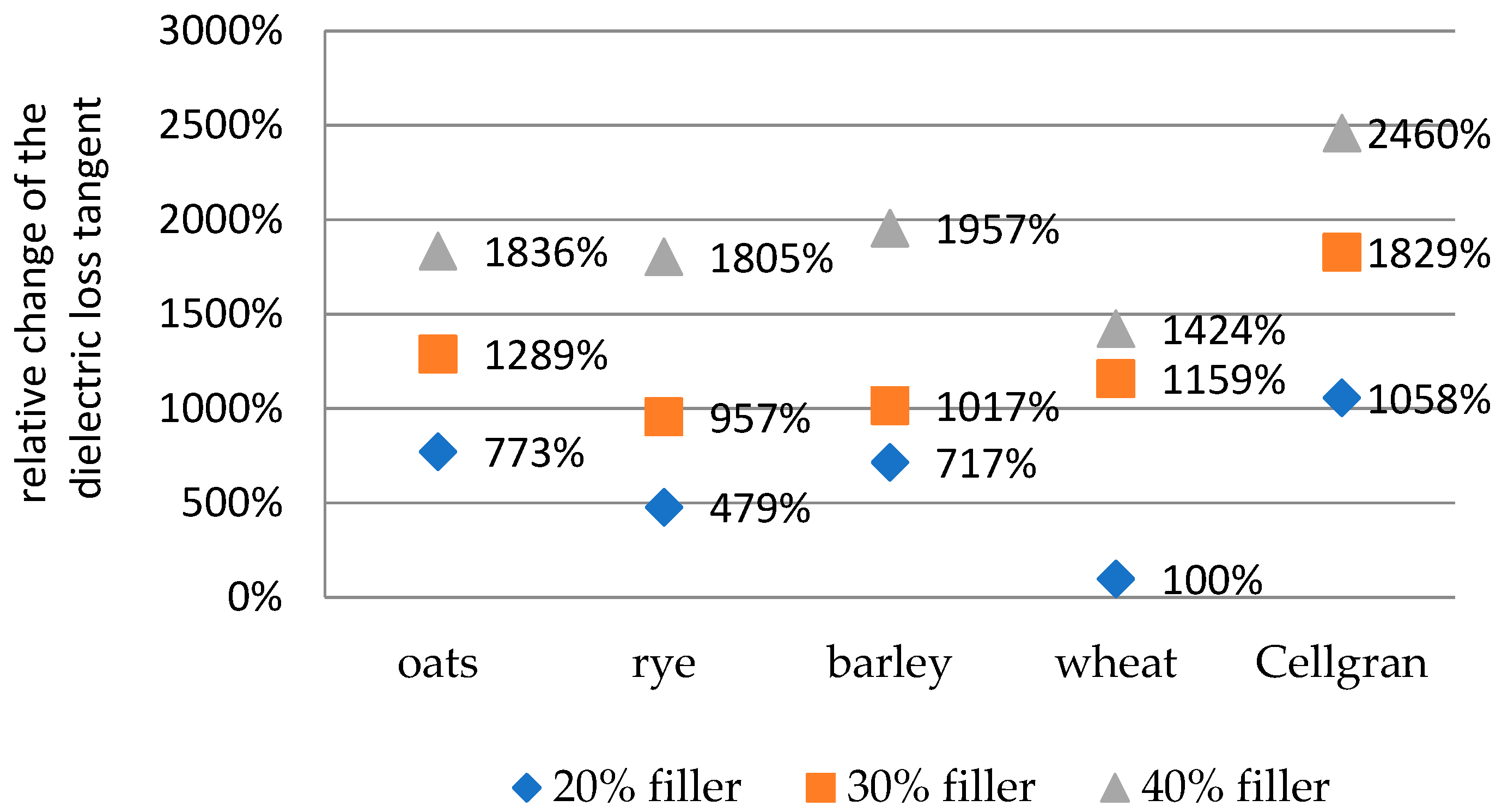
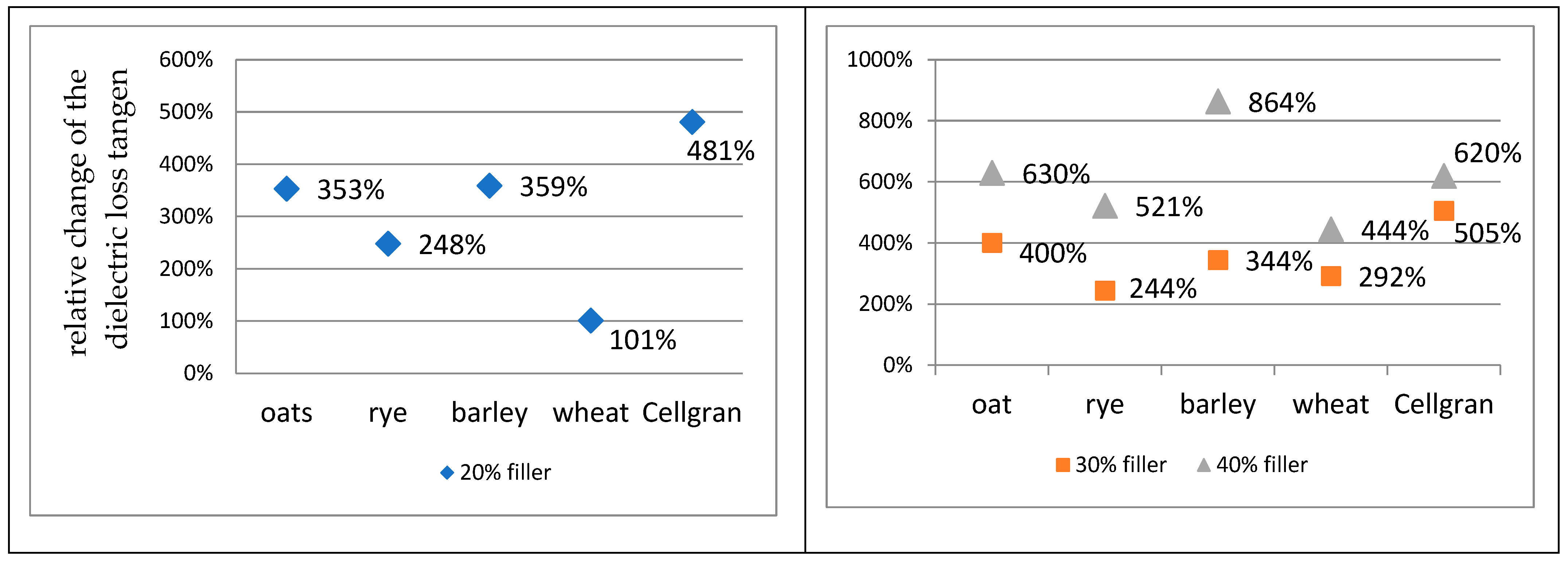
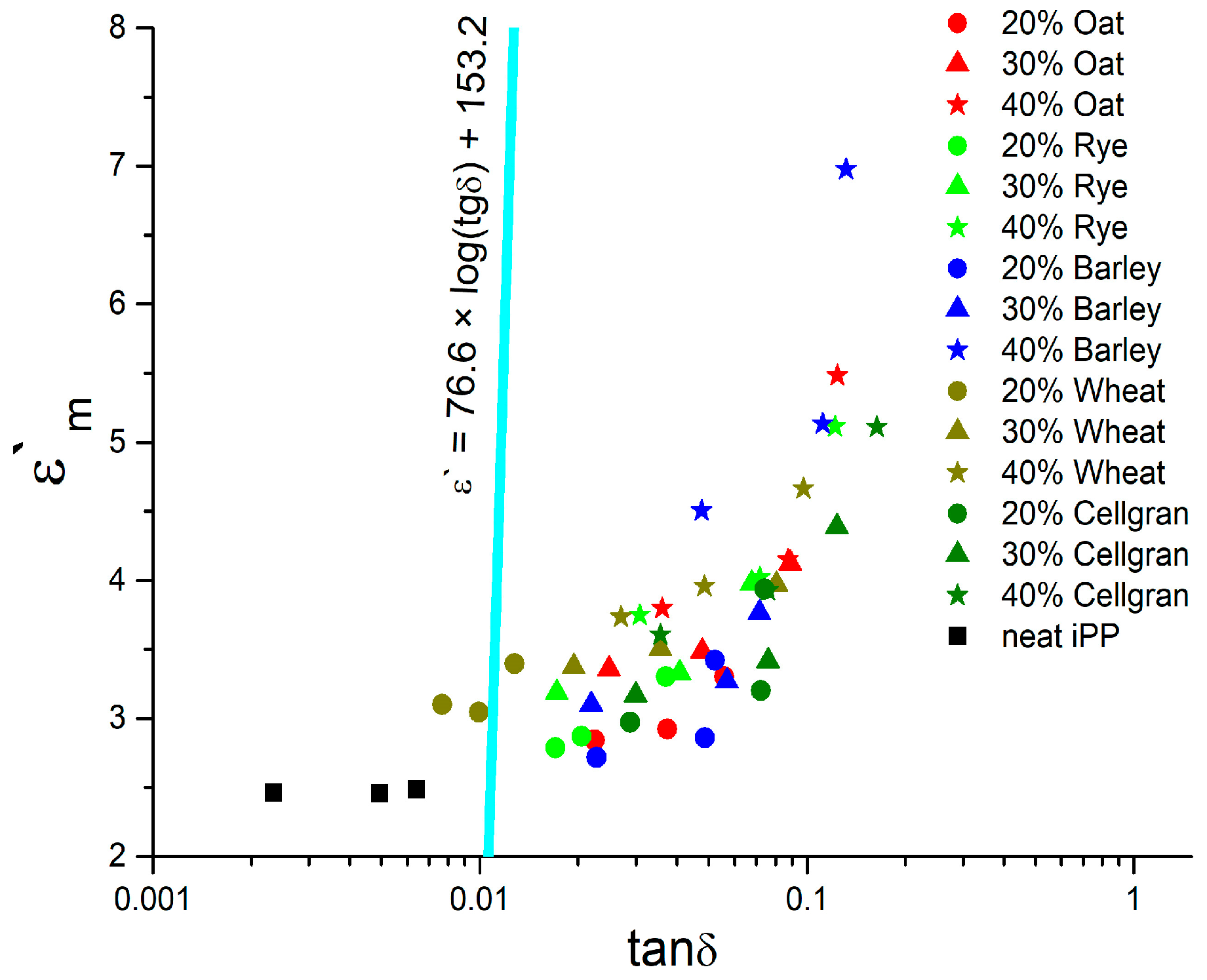
Disclaimer/Publisher’s Note: The statements, opinions and data contained in all publications are solely those of the individual author(s) and contributor(s) and not of MDPI and/or the editor(s). MDPI and/or the editor(s) disclaim responsibility for any injury to people or property resulting from any ideas, methods, instructions or products referred to in the content. |
© 2025 by the authors. Licensee MDPI, Basel, Switzerland. This article is an open access article distributed under the terms and conditions of the Creative Commons Attribution (CC BY) license (https://creativecommons.org/licenses/by/4.0/).
Share and Cite
Cerovic, D.D.; Petronijevic, I.M.; Marinkovic, F.S.; Maletic, S.B.; Popovic, D.M. Dielectric Properties of Isotactic Polypropylene with Lignocellulose-Based Biomass Filler. Materials 2025, 18, 1657. https://doi.org/10.3390/ma18071657
Cerovic DD, Petronijevic IM, Marinkovic FS, Maletic SB, Popovic DM. Dielectric Properties of Isotactic Polypropylene with Lignocellulose-Based Biomass Filler. Materials. 2025; 18(7):1657. https://doi.org/10.3390/ma18071657
Chicago/Turabian StyleCerovic, Dragana D., Ivan M. Petronijevic, Filip S. Marinkovic, Slavica B. Maletic, and Dusan M. Popovic. 2025. "Dielectric Properties of Isotactic Polypropylene with Lignocellulose-Based Biomass Filler" Materials 18, no. 7: 1657. https://doi.org/10.3390/ma18071657
APA StyleCerovic, D. D., Petronijevic, I. M., Marinkovic, F. S., Maletic, S. B., & Popovic, D. M. (2025). Dielectric Properties of Isotactic Polypropylene with Lignocellulose-Based Biomass Filler. Materials, 18(7), 1657. https://doi.org/10.3390/ma18071657







